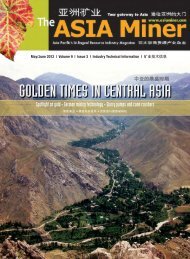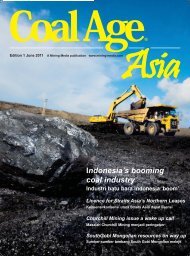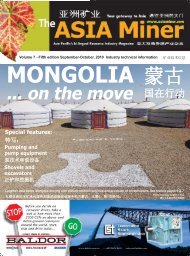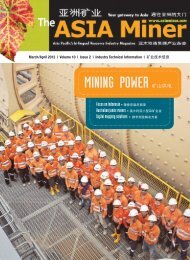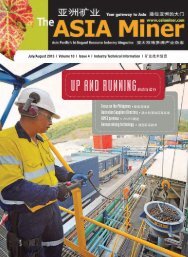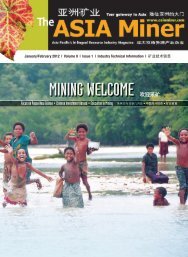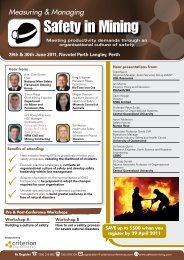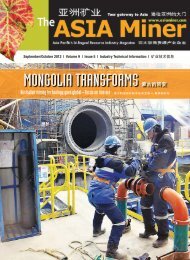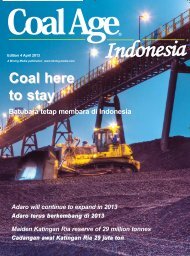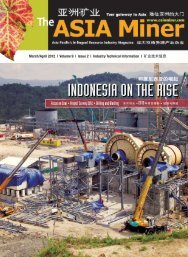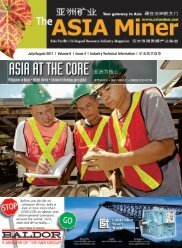May/June 2013 - The ASIA Miner
May/June 2013 - The ASIA Miner
May/June 2013 - The ASIA Miner
Create successful ePaper yourself
Turn your PDF publications into a flip-book with our unique Google optimized e-Paper software.
Malaysia<br />
J Resources to increase Penjom output<br />
PT J RESOURCES Asia Pacific Tbk intends spending around US$82<br />
million to increase production at the Penjom Gold Project in Pahang<br />
state. <strong>The</strong> planned capital program includes heavy equipment, river<br />
diversion and improvement of existing plant. <strong>The</strong> river diversion will<br />
enable J Resources to mine under the existing river bed.<br />
<strong>The</strong> company acquired Penjom through intermediary PT J Resources<br />
Nusantara along with several assets in Indonesia from UK mining company<br />
Avocet Mining plc in 2011. Those assets were placed directly under<br />
J Resources’ control early in 2012. In its last years of operation, Avocet<br />
did not invest significantly in the Penjom mine believing that it would soon<br />
be exhausted. J Resources aims to increase annual output from Penjom<br />
to 57,000 troy ounces this year, up from around 50,000 last year and also<br />
to extend the life of the mine, which is expected to close in 2017.<br />
J Resources’ corporate vice president, New Business Development<br />
& Exploration, Colin Davies, told <strong>The</strong> <strong>ASIA</strong> <strong>Miner</strong> at ozmine <strong>2013</strong> in<br />
Indonesia that the company believes the $82 million investment will<br />
extend the life of the mine and bring more benefits to the local people<br />
and to Malaysia as a whole.<br />
<strong>The</strong> Penjom operations will supply the bulk of J Resources’ total<br />
gold output of 103,000 ounces this year. J Resources also owns<br />
North Lanut mine in North Sulawesi and expects more production<br />
from the Bakan mine, also in North Sulawesi, and from Seruyung in<br />
East Kalimantan. <strong>The</strong>se three operations are in Indonesia. This year J<br />
Resources is spending $82 million on Bakan and another $74 million<br />
at Seruyung. <strong>The</strong> bulk of the investment is to build processing plants,<br />
in line with Indonesia’s new regulations regarding value adding.<br />
Mining under way at Buffalo Reef deposit<br />
ASSAY results from Monument Mining’s ongoing drilling program at<br />
Buffalo Reef deposit continue to define and extend the oxide and sulphide<br />
resources located next to its producing Selinsing open pit gold<br />
mine in Pahang state. Delivery of oxide material from Buffalo Reef to<br />
the Selinsing plant started in February <strong>2013</strong> and processing of these<br />
ores began in earnest in early March.<br />
Monument started its Buffalo Reef exploration program in 2010 with<br />
an initial US$800,000 budget for 5700 metres of drilling in 33 holes. As<br />
of December 2012 a total of 13,516 metres in 178 holes had been drilled.<br />
<strong>The</strong> first 8 drill holes totalling 947 metres were drilled for metallurgy<br />
Tenements owned by Monument Mining at the Selinsing and Buffalo Reefs deposits<br />
in Pahang state.<br />
testing and were completed by October 2011. Drilling since October<br />
2011 has focused on exploration and resource definition adjacent to<br />
and along strike from the known North, Central and South resources,<br />
including the area between Buffalo Reef South and the Selinsing pit.<br />
<strong>The</strong> <strong>2013</strong> financial year Buffalo Reef drilling, budgeted at US$4.44<br />
million, not including assays and labour, began on July 1 and includes<br />
5171 metres of reverse circulation (RC) drilling and 10,825 metres of<br />
diamond drilling. By the end of December, 50 diamond drill holes totalling<br />
4785.9 metres and 93 RC holes totalling 4611 metres had been<br />
completed. From January 1 to March 31 a total of 26 drill holes totalling<br />
3225.8 metres were completed at Buffalo Reef and sampling<br />
and/or assays for these drill holes are in progress. <strong>The</strong>re are three exploration<br />
drills operating at Selinsing and Buffalo Reef.<br />
<strong>The</strong> best results from assays received to date are: 9.0 metres from<br />
9.5 metres @ 6.60 grams/tonne gold in oxide and two separate underlying<br />
zones of 2.9 metres from 71 metres @ 3.22 grams/tonne and<br />
7.4 metres from 75.6 metres @ 3.88 grams/tonne; 14.3 metres from<br />
surface @ 4.91 grams/tonne gold in oxide; 3.0 metres from 13 metres<br />
@ 2.56 grams/tonne and 10 metres from 22 metres @ 5.63<br />
grams/tonne in oxide; and7.0 metres from 22 metres @ 3.71<br />
grams/tonne gold in oxide and an underlying zone of 7.0 metres from<br />
29 metres @ 3.63 grams/tonne gold in sulphide. <strong>The</strong>se results demonstrate<br />
that mineralization at the Buffalo Reef deposit continues at<br />
depth along several east-dipping structural zones. Oxide materials<br />
exposed in the Buffalo Reef South resource are being mined.<br />
Buffalo Reef South has been pre-stripped of overburden with mining<br />
beginning in the first quarter of <strong>2013</strong>. Long-term planning enabled the<br />
overburden to be used for the nearby TSF upgrade and precluded<br />
the need at this stage to establish a new waste dump. Buffalo Reef<br />
oxide materials are targeted to contribute about 13,000 tonnes of mill<br />
feed to the Selinsing mill on a monthly basis for the remainder of the<br />
<strong>2013</strong> financial year. Additional metallurgy test work is in progress on<br />
sulphide refractory mineralization from the Buffalo Reef Central resource<br />
zone to confirm the excellent gold recovery results (using flotation,<br />
bio-oxidation, and CIL processing) achieved at Buffalo Reef<br />
South and North resource zones.<br />
34 | <strong>ASIA</strong> <strong>Miner</strong> | <strong>May</strong>/<strong>June</strong> <strong>2013</strong>



